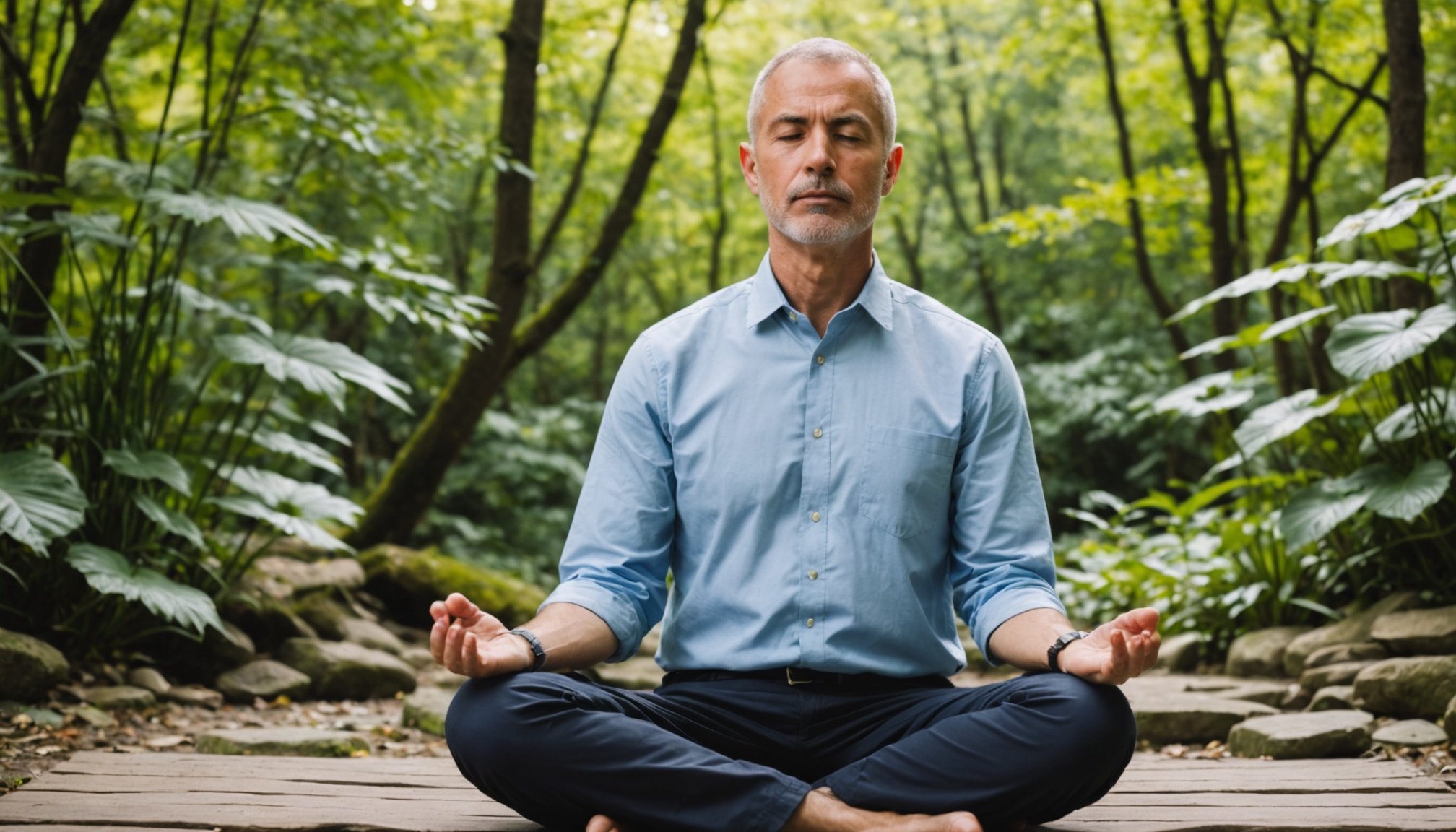Unlocking Calm: The Role of Mindfulness Meditation in Easing Generalized Anxiety Disorder Symptoms
In a world where anxiety has become a pervasive companion for many, finding effective and accessible ways to manage its symptoms is crucial. One of the most promising approaches is mindfulness meditation, a practice that has been extensively studied and proven to offer significant benefits for mental health. Here, we delve into the world of mindfulness meditation, exploring how it can help ease the symptoms of Generalized Anxiety Disorder (GAD) and why it should be a part of your mental health toolkit.
Understanding Generalized Anxiety Disorder
Before we dive into the specifics of mindfulness meditation, it’s essential to understand what Generalized Anxiety Disorder is. GAD is characterized by excessive and persistent worry about everyday things, even when there is no apparent reason to worry. This anxiety can interfere with daily life, causing significant distress and impairment.
Also to see : Exploring the Connection Between Sleep Quality and Cognitive Decline in Aging Adults
| Symptoms of GAD | Description |
|
|-----------------------------------------------------------------------------|
| Excessive Worry | Persistent and uncontrollable worry about various aspects of life. |
| Restlessness | Feeling on edge or restless. |
| Fatigue | Feeling tired or lacking energy. |
| Difficulty Concentrating | Trouble focusing on tasks due to anxiety. |
| Irritability | Feeling easily annoyed or irritable. |
| Muscle Tension | Physical tension, such as tight muscles. |
| Sleep Disturbances | Difficulty falling or staying asleep due to anxiety. |
The Concept of Mindfulness Meditation
Mindfulness meditation is a practice rooted in the concept of mindfulness, which involves paying careful attention to the present moment without judgment. This technique, often associated with Buddhist traditions, has been adapted and secularized for modern use.
How to Practice Mindful Breathing
One of the most basic and effective forms of mindfulness meditation is mindful breathing. Here’s how you can practice it:
Also to see : Unlocking Healing: The Role of Music Therapy in Aiding Neurological Disorder Recovery
- Focus on Your Breath: Start by focusing your attention on your breath, observing the inhale and exhale without trying to adjust it. You might notice the sensation of the breath in your nostrils, the rise and fall of your chest, or the expansion of your abdomen[1].
- Use Guided Meditations: For added structure, you can use guided meditations. For example, you can start with an exaggerated breath: a deep inhale through your nostrils (3 seconds), hold your breath (2 seconds), and a long exhale through your mouth (4 seconds)[1].
- Manage Mind Wandering: It’s natural for your mind to wander. When this happens, gently acknowledge the thought and redirect your attention back to your breath.
The Benefits of Mindfulness Meditation for Anxiety
Mindfulness meditation has been extensively researched for its benefits in managing anxiety, and the results are compelling.
Reducing Stress and Anxiety
Mindfulness gives us distance from our thoughts and feelings, helping us tolerate and work through unpleasant emotions without becoming overwhelmed. By focusing on the breath, mindfulness meditation provides an anchor in the present moment, distracting us from stressful thoughts and worries about the past or future[1].
Improving Emotional Regulation
Studies have shown that mindfulness practices, such as focused breathing, can improve emotional regulation. For instance, a study by Arch and Craske found that Americans who completed a 15-minute focused breathing exercise reported less negative emotion in response to negative images compared to those who did not complete the exercise[1].
Enhancing Mental Health
Mindfulness-based techniques are integral to various psychotherapy approaches for anxiety relief. These techniques encourage present-moment awareness, reducing anxiety by promoting relaxation and self-awareness. For example, mindfulness-based stress reduction (MBSR) programs, developed by Jon Kabat-Zinn, have been widely adopted for their effectiveness in managing chronic pain, stress, and anxiety[2].
How Mindfulness Meditation Works
To understand why mindfulness meditation is so effective, let’s look at the underlying mechanisms.
Activating the Parasympathetic Nervous System
Mindfulness meditation activates the parasympathetic nervous system, which counteracts the body’s stress response and promotes relaxation. This activation helps in reducing overall anxiety levels by calming the brain and body[4].
Enhancing Cognitive Function
Mindfulness practices can improve cognitive functions such as attention and concentration. By regularly practicing mindfulness, individuals can sharpen their skills of attention, which is crucial for managing anxiety and improving mental health[1].
Reducing Chronic Pain and Stress
Mindfulness meditation is not just beneficial for anxiety; it also helps in managing chronic pain and stress. By focusing on the present moment, individuals can reduce their perception of pain and stress, leading to improved overall health[4].
Other Mindfulness-Based Techniques for Anxiety
While mindful breathing is a powerful tool, there are other mindfulness-based techniques that can be equally effective.
Body Scan Meditation
Body scan meditation involves lying down or sitting comfortably and bringing your attention to different parts of your body, starting from your toes and moving up to the top of your head. This practice enhances body awareness and relaxation, helping to reduce anxiety symptoms[2].
Guided Imagery
Guided imagery involves using visualization techniques to promote positive emotions and calmness. This can be done through guided meditations where you imagine yourself in a peaceful and safe environment, helping to reduce anxiety and stress[2].
The 333 Rule
The 333 rule is a simple yet effective grounding technique that involves identifying three objects you can see, hear, and touch or move. This technique helps shift your attention to the present moment, reducing anxiety by focusing on your surroundings[3].
Integrating Mindfulness into Daily Life
To maximize the benefits of mindfulness meditation, it’s essential to integrate it into your daily routine.
Starting Small
Begin with short sessions, such as 5-minute mindfulness exercises, and gradually increase the duration as you become more comfortable with the practice. Consistency is key; aim to practice mindfulness every day, even if it’s just for a few minutes[4].
Creating a Daily Routine
Incorporate mindfulness exercises into your morning or evening routine. This could be as simple as taking a few deep breaths before starting your day or practicing a guided meditation before bed[4].
Being Flexible
Adapt the frequency and duration of your mindfulness practice based on your daily stress levels and personal comfort. Listen to your body and adjust your practice accordingly[4].
Practical Insights and Actionable Advice
Here are some practical tips to help you get started with mindfulness meditation:
- Find a Quiet Space: Identify a quiet and comfortable space where you can practice mindfulness without distractions.
- Use Guided Meditations: Start with guided meditations to help you stay focused and learn the techniques.
- Be Consistent: Aim to practice mindfulness daily, even if it’s just for a few minutes.
- Combine with Other Techniques: Integrate mindfulness with other self-care activities such as exercise, journaling, or nature walks to create a holistic approach to managing anxiety[2].
Real-Life Examples and Anecdotes
Many people have found mindfulness meditation to be a game-changer in managing their anxiety. Here’s an example:
“I was struggling with anxiety for years, and it was affecting my daily life significantly. I started practicing mindfulness meditation, and within a few weeks, I noticed a significant reduction in my anxiety levels. Now, I practice mindfulness every day, and it has become an essential part of my mental health routine.” – Sarah, a mindfulness practitioner.
Research and Evidence
The effectiveness of mindfulness meditation in managing anxiety is backed by numerous studies.
Study Findings
A 2017 review of 16 articles suggested that mindfulness may be an effective part of treatment for mood and anxiety disorders. Another study found that shorter mindfulness interventions can be beneficial and may produce greater effects on mindfulness and stress than longer interventions[3].
Comparison of Mindfulness-Based Therapies
Here is a comparison of different mindfulness-based therapies and their benefits:
| Therapy | Focus | Benefits |
|---|---|---|
| Mindfulness-Based Stress Reduction (MBSR) | Present-moment awareness to reduce stress and anxiety. | Reduces chronic pain, stress, and anxiety; improves emotional regulation. |
| Mindfulness-Based Cognitive Therapy (MBCT) | Combines mindfulness with cognitive therapy to prevent relapse. | Helps in preventing relapse of depression; reduces anxiety symptoms. |
| Acceptance and Commitment Therapy (ACT) | Acceptance of thoughts and emotions while taking action towards values. | Improves emotional regulation; enhances psychological flexibility. |
| Dialectical Behavior Therapy (DBT) | Combines mindfulness with CBT skills for emotional regulation. | Reduces self-destructive behaviors; improves emotional regulation. |
Mindfulness meditation is a powerful tool for managing Generalized Anxiety Disorder symptoms. By focusing on the present moment, reducing stress, and enhancing emotional regulation, mindfulness practices offer a holistic approach to mental health. Whether you’re just starting out or looking to deepen your practice, incorporating mindfulness meditation into your daily routine can be a transformative step towards a calmer, more resilient you.
As Jon Kabat-Zinn, the founder of MBSR, once said, “The best way to take care of the future is to take care of the present moment.” By practicing mindfulness, you’re not just managing your anxiety; you’re cultivating a healthier, more mindful approach to life.











